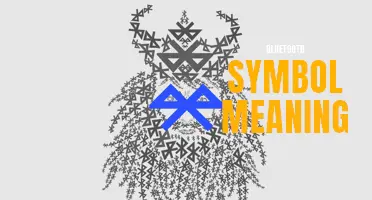
Map symbols are like a secret code that helps us navigate through the vast world of maps. They are small illustrations or markings that represent features such as roads, buildings, bodies of water, and natural landmarks. Understanding what these symbols mean is like learning a new language that allows us to decipher and interpret maps with ease. By unlocking the meaning behind these symbols, we gain the ability to explore and navigate our surroundings with confidence, whether it be a neighborhood map or a topographic map of a mountainous region. So, join me on a journey of discovery as we unravel the mystery of map symbols and uncover the hidden meanings they hold.
What You'll Learn
- What are map symbols and how are they used in cartography?
- How do map symbols vary depending on the type of map being created?
- What are some common map symbols used to represent natural features, such as rivers or mountains?
- How can understanding map symbols help with navigation and understanding the layout of an area?
- Are there any international standards or conventions for map symbols, or do they vary from country to country?

What are map symbols and how are they used in cartography?
Map symbols are an essential aspect of cartography, the art and science of creating maps. They are graphic representations used to communicate and depict various features or objects on a map. These symbols help map readers to understand what is being represented on the map and provide key information about the geography and features of a particular area.
Map symbols can represent a wide range of features, such as cities, rivers, roads, buildings, mountains, forests, and airports. They are designed to be visually distinct and easily recognizable, allowing map readers to quickly identify and interpret the information being presented.
The use of map symbols dates back to ancient times when early cartographers used basic pictorial representations to denote various features on their maps. Over time, map symbols have evolved and become standardized to ensure consistency and clarity across different maps and mapmakers.
Today, there are internationally recognized symbols that are commonly used in cartography. These symbols are often included in map legends or keys, which provide a detailed explanation of the different symbols and their meanings. For example, a dot inside a circle might represent a city or town, while a wavy line might represent a river.
Map symbols are not only used to represent natural and man-made features but also to indicate additional information about them. For example, a small square with an "H" might represent a hospital, while a triangle with an "S" might represent a school. These symbols provide useful information at a glance and help map users navigate and understand the map more easily.
In addition to their functional purpose, map symbols also have aesthetic and artistic value. Cartographers often put careful thought and consideration into the design and placement of symbols to create visually appealing and informative maps. The use of color, size, and style adds visual interest and helps to convey additional information or emphasize certain features.
Overall, map symbols play a crucial role in the field of cartography. They allow map readers to quickly and accurately interpret maps, making them an essential tool for navigation, planning, and understanding the world around us. Whether used in physical maps or digital mapping applications, map symbols continue to be an important element of effective and communicative cartography.
The Hidden Meanings Behind the Arrowhead Symbol
You may want to see also

How do map symbols vary depending on the type of map being created?
Map symbols are an integral part of cartography, as they provide essential information about the features represented on a map. These symbols vary depending on the type of map being created, as different maps have different purposes and require different kinds of information to be displayed.
One type of map that commonly uses map symbols is a topographic map. Topographic maps are primarily concerned with representing the physical features of the Earth's surface, such as mountains, rivers, forests, and the contour lines that indicate changes in elevation. Symbols on topographic maps are usually simple and easily recognizable, allowing the user to quickly identify and understand the features shown. For example, a mountain may be represented by a triangle, while a river may be represented by a wavy line.
In contrast, a political map focuses on showing the boundaries and divisions of countries, states, and other administrative units. The symbols used in political maps may include dotted lines to indicate disputed boundaries or dashed lines to represent boundaries that are still under negotiation. Different colors may also be used to distinguish between different types of political boundaries, such as national borders, state boundaries, and county boundaries.
Another type of map that uses map symbols is a weather map, which provides information about current weather conditions and forecasts. Weather symbols are used to represent various weather phenomena, such as clouds, precipitation, temperature, wind direction, and air pressure. For example, a cloud symbol with lines coming out of it may indicate rain, while a cloud symbol with snowflakes falling from it may indicate snow.
Symbols on transportation maps vary depending on the type of transportation being represented. On a road map, symbols may be used to indicate different types of roads, such as highways, secondary roads, and local streets. These symbols can help guide drivers and travelers in planning their routes. On a subway or metro map, symbols may be used to represent different subway lines and stations, allowing passengers to easily navigate the system.
Symbols on thematic maps, which focus on specific themes or topics, also vary depending on the subject being represented. For example, on a population density map, symbols may be used to indicate different levels of population density in different areas. On a vegetation map, symbols may be used to represent different types of vegetation, such as forests, grasslands, and deserts.
In conclusion, map symbols vary depending on the type of map being created. Different types of maps have different purposes and require different kinds of information to be displayed. Understanding these symbols is crucial for interpreting maps accurately and efficiently. Whether it's a topographic map, political map, weather map, transportation map, or thematic map, symbols play a vital role in conveying information and facilitating understanding for map users.
Decoding the Enigma: Understanding the Meaning Behind Dyson Vacuum Symbols
You may want to see also

What are some common map symbols used to represent natural features, such as rivers or mountains?
Map symbols are graphical representations used on maps to represent various features such as rivers, mountains, or other natural landforms. These symbols help readers understand and interpret the information conveyed by the map.
Rivers are commonly represented on maps using a variety of symbols. A blue line is usually used to indicate the course of a river. The thickness of the line may indicate the size or importance of the river. Additionally, a small blue arrow may be placed along the line to indicate the direction of the river's flow. Sometimes, the symbol of waves or water droplets can also be used to represent rivers.
Mountains are often represented using contour lines. Contour lines are curved lines that connect points of equal elevation. These lines form shapes that represent the shape of the land, including mountains. The closer the contour lines are to each other, the steeper the slope of the mountain. Sometimes, mountaintops are indicated by small triangles or peaks.
Other natural features, such as forests or woodlands, are also commonly represented on maps. These are shown using symbols that resemble trees. The density of the trees can be indicated by either filling the symbol with solid black or by using different shades of green.
Lakes and ponds are represented as similar blue symbols to rivers, but without the flow arrows. These symbols often depict the shape of the water body and may include labels indicating their names or important information about them.
Other common natural features represented on maps include swamps, wetlands, deserts, and beaches. These features are displayed using specific symbols that are easily recognizable. For example, swamps and wetlands may be represented using a series of small, interconnected squiggly lines. Deserts are often represented using a series of dots or small triangles, while beaches are indicated by a shoreline symbol with hatching to represent sand.
In addition to these natural features, maps can also show man-made features, such as roads, buildings, or railways. These features are typically represented using different symbols and colors, making it easy for readers to identify them.
Overall, map symbols are crucial elements for understanding and interpreting maps. They provide a visual language that allows us to navigate and understand the various natural and man-made features depicted on a map. By learning and recognizing these symbols, we can more effectively interpret maps and make sense of the world around us.
The Deep Symbolic Meaning Behind the White Rose
You may want to see also

How can understanding map symbols help with navigation and understanding the layout of an area?
Map symbols are a crucial part of understanding and navigating any area or territory. These symbols provide valuable information about the various features and landmarks present in a region, enabling individuals to easily comprehend the layout and characteristics of a specific area. Understanding map symbols is essential not only for successful navigation but also for gaining insights into the geography and topography of a particular location.
One of the primary benefits of understanding map symbols is that it allows individuals to navigate through unfamiliar territories accurately. By recognizing and interpreting the map symbols, people can identify key points of interest, such as landmarks, rivers, roads, and buildings. These symbols act as a concise and visual representation of important features, enabling individuals to plan their routes efficiently and reach their desired destinations without getting lost.
Moreover, understanding map symbols also facilitates a better understanding of the physical and human-made features in an area. Symbols for natural elements like mountains, forests, and bodies of water provide information about the terrain and the type of landscape one might encounter. On the other hand, symbols for man-made structures such as hospitals, schools, and churches can give a sense of the services and amenities available in a specific neighborhood or city.
Additionally, map symbols are designed to convey information in a universally understood manner. Whether someone is looking at a map in their own country or navigating a foreign land, the symbols used are generally standardized, making them recognizable and interpretable regardless of language or cultural barriers. This universality allows individuals from different backgrounds and regions to access and interpret maps accurately, facilitating effective communication and collaboration.
Understanding map symbols is not only beneficial for navigation but also for developing a deeper appreciation for the environment. By identifying features such as forests or national parks, individuals can gain a better understanding of the natural spaces around them, promoting a sense of environmental awareness and encouraging exploration of these areas. This knowledge can also be valuable for educational purposes, as it allows students to connect theoretical concepts with real-world applications.
In conclusion, map symbols play a crucial role in navigation and understanding the layout of an area. By recognizing and interpreting these symbols, individuals can navigate through unfamiliar territories, understand the geography and topography of a region, and gain a deeper appreciation for the environment. Whether it is for practical purposes, such as finding a specific location, or for educational purposes, understanding map symbols is an essential skill that allows individuals to make the most of their surroundings.
The Symbolic Meaning of Donkey in the Bible: Lessons of Humility and Service
You may want to see also

Are there any international standards or conventions for map symbols, or do they vary from country to country?
When it comes to navigation and understanding geography, map symbols play a crucial role. These symbols provide a visual representation of various features and elements found on a map, making it easier for users to interpret and navigate through the information presented. While different countries may have their own unique set of symbols and conventions, there are also international standards and conventions in place.
International standards and conventions for map symbols are essential for maintaining consistency and ensuring that maps can be universally understood. They help provide clarity and avoid confusion, particularly when it comes to international navigation or collaboration between different countries.
One of the most widely recognized international standards for map symbols is the International Organization for Standardization (ISO) 7001:2007. This standard provides guidelines for the design and use of symbols for public information. While it doesn't specifically focus on map symbols, many of the principles and recommendations outlined in this standard can be applied to map symbol design.
In addition to ISO 7001:2007, the United Nations (UN) also plays a role in standardizing map symbols. The UN provides guidelines and recommendations for the use of certain symbols in different contexts, such as maritime navigation or aviation. For example, the International Hydrographic Organization (IHO), which is a specialized agency of the UN, has developed standards for nautical charts and publications that include specific symbol conventions for marine navigation.
Apart from international standards and conventions, countries often have their own set of symbols and conventions that are tailored to their specific needs and preferences. These national symbols can vary in design, color, and style, but generally adhere to the principles of simplicity, clarity, and consistency.
For example, in the United States, the U.S. Geological Survey (USGS) has developed a set of map symbols known as the "USGS Topographic Map Symbols." These symbols are widely used in topographic maps and provide information about natural and man-made features, such as mountains, rivers, roads, and buildings.
Similarly, in the United Kingdom, the Ordnance Survey (OS) has its own set of map symbols known as "OS Explorer Map Symbols." These symbols are used in OS Explorer Maps and provide information about various features found in the British landscape, including landmarks, footpaths, and geographic boundaries.
Despite the presence of national symbols, efforts are being made to harmonize and standardize map symbols on a regional and global scale. Organizations like the International Cartographic Association (ICA) and the International Standards Organization (ISO) work towards the development and adoption of unified symbol sets that can be understood by map users worldwide.
In conclusion, while map symbols can vary from country to country, there are international standards and conventions in place to ensure consistency and ease of understanding. These standards provide guidelines for the design and use of symbols, promoting clarity and avoiding confusion. However, individual countries may still have their own unique symbols and conventions tailored to their specific needs. Efforts are being made towards harmonization and standardization on a global scale to enhance international collaboration and navigation.
Unraveling the Hidden Meanings of Dreidel Symbols: A Deeper Look into the Hanukkah Traditions
You may want to see also
Frequently asked questions
A circle on a map symbol usually represents a point of interest or a location. It could indicate a landmark, such as a church or a monument, or it could mark the position of a town or city. The circle can also represent a specific point on the map where something important or significant is located.
A wavy line on a map symbol typically represents a body of water, such as a river, stream, or lake. The wavy line is used to indicate the flow or presence of water, and its shape can help to determine the size and type of water feature it represents. For example, a wider or more pronounced wavy line may indicate a larger river, while a smaller or less distinct line may represent a smaller stream or creek.
A dashed line on a map symbol generally indicates a boundary or a division between different areas or regions. It could represent a political border, such as the line between two countries or between states, or it could mark the boundary of a protected area or nature reserve. The dashed line is often used to visually differentiate between different territories or jurisdictions on a map.
A triangle on a map symbol is commonly used to represent a mountain or a hill. The shape of the triangle can provide additional information about the specific terrain feature it represents. For example, a tall and pointed triangle may indicate a peak or a summit, while a wider or flatter triangle may represent a lower elevation or a foothill.
A star on a map symbol is typically used to denote a significant or important location. It could mark the position of a capital city, major city, or an important tourist attraction. The star symbol can help to draw attention to a specific point of interest on the map and can provide valuable information for navigating and exploring the area.







